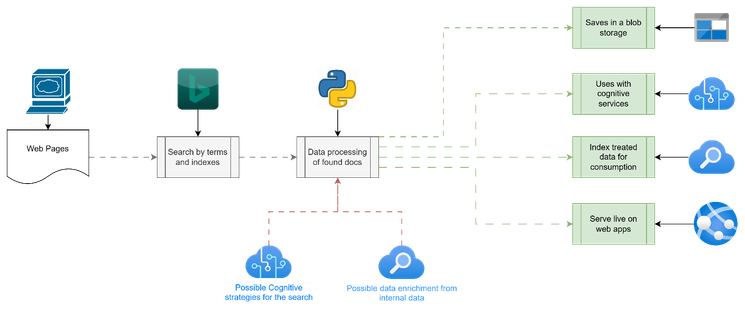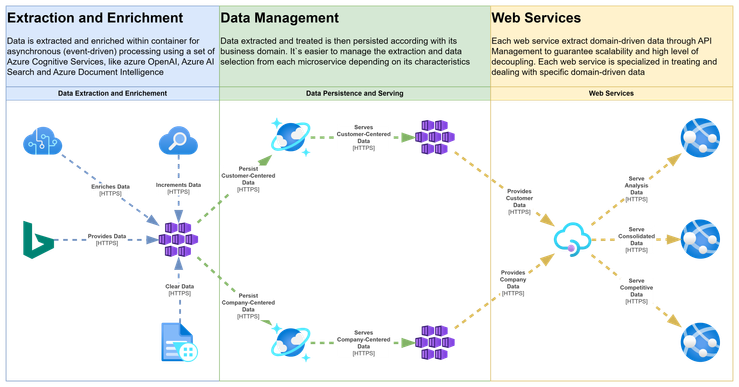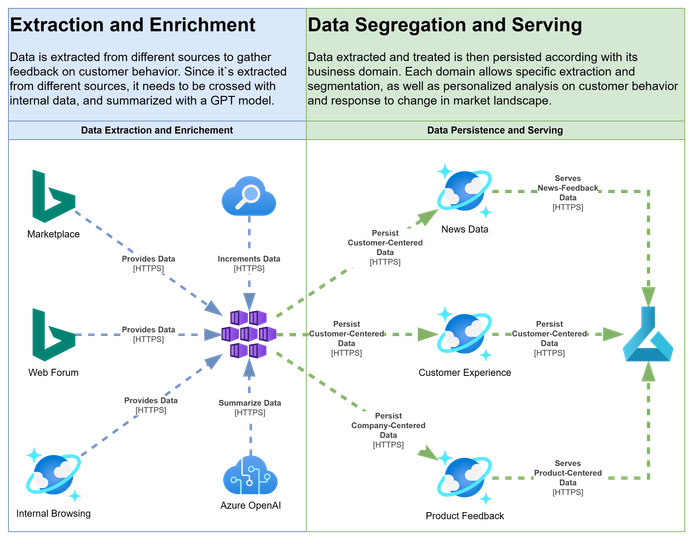This post has been republished via RSS; it originally appeared at: New blog articles in Microsoft Community Hub.
In the contemporary digital landscape, data has emerged as an invaluable asset, pivotal not just for the operational needs of AI within a company, but also as a vital tool for garnering competitive intelligence, understanding market dynamics, and identifying the distribution of opportunities.
Given this context, the establishment of a robust and efficient system for data extraction from the internet is essential. Equally important is the development of an internal data search engine, which facilitates the rapid and reliable retrieval of information from diverse sources, thereby enhancing the organization's comprehension of its operational environment, opportunities, and threats.
In delving into the methodologies for extracting, processing, standardizing, and utilizing data, it is critical to acknowledge that the strategies for employing external information should diverge from those used for internal data. This distinction is predicated on two key factors. Firstly, internal data is typically more structured, or at least better contextualized, compared to external data. Secondly, internal data provides a deeper insight into the internal operational processes, whereas external data offers a strategic perspective, primarily related to market trends and dynamics.
This discourse aims to explore the implementation of Bing as a search engine for internet-derived data. This approach enables organizations to augment their data pipelines with information sourced from the internet, thereby enriching their internal data repositories. Such an enhancement is crucial for informed decision-making and efficient operational management. This exploration will illuminate the potential of leveraging Bing to transform the way businesses interact with, and benefit from, both external and internal data sources.
Data analysis with web information
In today's rapidly evolving business landscape, the effective utilization of data has become a cornerstone for operational success and innovation. The exponential growth of technology is reshaping the way businesses operate, with disruptive technologies leading the charge.
One of the most pivotal shifts is the transition towards a culture of continuous learning and tech literacy across all levels of an organization. This approach involves embedding learning directly into the workflow, allowing employees to acquire and apply new skills in real-time, which is crucial for adapting to evolving technological landscapes. Companies like Netflix have exemplified this by integrating data science into various business units to enhance experimentation and learning. This "LearnOps" approach is a strategic blend of operational processes and continuous learning, fostering an environment where employees are constantly evolving and adapting their skills to meet the demands of new technologies (McKinsey & Company) .
Emerging technologies such as Artificial Intelligence (AI), the Internet of Things (IoT), and big data are reshaping the foundational aspects of business operations. AI is becoming more accessible and versatile, extending its capabilities beyond traditional tech roles to a broader user base within organizations. The Internet of Things is enhancing business operations by providing real-time data and insights, enabling more efficient and automated processes. Additionally, the burgeoning volume of big data allows for more informed decision-making, offering predictive insights that can significantly impact various aspects of business operations, from supply chain management to customer engagement strategies (InformationWeek) (Wharton Online) .
Moreover, generative AI is emerging as a transformative force, capable of impacting a wide array of jobs and creating significant economic value. It's not just about automation but enhancing human potential, enabling workers to achieve tasks that were previously impossible. This advancement in AI signifies a major shift towards more human-centric technology, reshaping our interaction with data and decision-making processes (Newsroom | Accenture) .
In essence, the integration of these disruptive technologies into business operations isn't just an option but a necessity for staying competitive and innovative. By embracing these technologies, companies can unlock new levels of efficiency, creativity, and growth. It's crucial for businesses to continuously assess and integrate these technologies into their operations, not only to keep pace with the market but to redefine their position in the industry.
Enhancing your internal data with Bing
In the realm of competitive business intelligence, various methodologies can be employed to harness the capabilities of Bing and generative AI for comprehensive market analysis. Bing, for instance, can be instrumental in gathering data on the market shares of different telecommunications companies.
Bing has proven useful in gathering data on market shares in the telecommunications sector. This data, when analyzed with advanced generative AI models, provides a deeper understanding of market dynamics. These models help in identifying the key players and understanding the distribution of market share within the industry. Subsequently, this data can be meticulously analyzed using advanced generative AI models. These models facilitate a nuanced understanding of the distribution of market share within the industry, enabling identification of leading players and trends.
Vodafone is a notable example where Microsoft Azure AI services were utilized to create TOBi, a conversational digital assistant. This AI-powered assistant improved customer satisfaction and efficiency in handling customer conversations, demonstrating the significant impact of AI in enhancing customer experience in telecommunications (MS Cloud & Tech).
Furthermore, the integration of Bing and generative AI for the analysis of customer reviews and social media mentions can yield profound insights into consumer sentiment and preferences. Such analyses are crucial in pinpointing areas where a company can enhance its offerings to align more closely with customer needs, thereby securing a competitive edge. Bing’s utility extends to the exploration of competitors' pricing strategies. Data extracted via Bing can be processed through machine learning models to uncover patterns and trends in industry pricing. This intelligence is invaluable in formulating competitive pricing strategies.
The analysis of product offerings and features through Bing and generative AI provides deep insights into the strengths and weaknesses of competitors' products. Leveraging this information, companies can innovate and develop products and services that more effectively meet customer demands and outpace competitors. In addition to product and pricing strategies, Bing and generative AI can be pivotal in assessing brand perception. Understanding how a company is perceived in comparison to its competitors can guide the development of effective branding and marketing strategies, distinguishing the company in a crowded marketplace.
The methodologies converge in a comprehensive data processing approach that involves leveraging Bing for diverse data sources, including web documents and internal documents. The consolidation of this data in Azure Blob Storage allows for the transformation of raw data into actionable market analysis and sales strategy insights. Large Language Models (LLMs) can be employed to refine this data further, using aggregation, indexing, and the incorporation of new data sources to enhance the depth and accuracy of the market insights derived. The general logical flow for using Bing as your web data extraction engine is as follows:
Business Cases and Reference Architectures
As we discuss the advantages and examples of why Bing should be your preferred tool for web scrapping and indexing, we also see clear opportunities in a daily basis for using Bing on different stages of the data pipeline, with different strategies for managing the web information, and applying this general knowledge on the AI Apps being built in the company. Let’s discuss the most interesting and disruptive ones in detail.
One important disclaimer is that you should always take care with the web scrapping policies of the websites that you’re indexing information from. Whenever one API is available, it’s preferable to web scrapping because they have proper mechanisms for managing the traffic and the requests, as well as monitoring the behavior for each user. The methods mentioned here are useful for situations where the information is publicly available and there are no restrictions on the usage of the scrapped information on your intended usage.
Extracting Competitive Information
Imagine the following use case: you have a compete that is critical due to its presence with a given client. In this scenario, it’s important to have a strategy where you have the most information available and curated about this compete, from the strengths and weakness of its product, to the general adoption and market recognition.
In this scenario, a knowledge base of every important aspect of the competition is fundamental. Not only to understand when they really have one advantage, but also to understand whether this advantage is consistent with the market needs or if it’s based on impressions and brand bias. What is critical here is the capacity to gather information efficiently and summarize the major compete aspects of each important product.
Due to the nature of real-time investigative behavior of the application, it might not need a historical information, and due to the asynchronous nature of the process, it is an interesting usage of provisioned capacity to create drafts for internal compete reports. So, we basically suggest, in this case, a solution architecture for a compete report writer that can be executed in background.
Identifying Customer Behavior
Most of the major competitive advantages comes from properly understanding what customers want and adapt the portfolio so you have items specifically tailored for each user case. To achieve a higher degree of feature matching with customers tastes, it`s critical to understand how the customer behaves on its interactions with the product.
Think about it: why does your customers purchase your products if not for recognizing that they are better matched (both in price and quality) with your product features? Therefore, how may you identify feature characteristics that your customer prefers or not, and how could you gather data that would give you hints and directions over their behavior?
Since in modern times every person has its browsing footprint, you can retrieve persona behavior based on public and anonymous data, like feedback on marketplaces, using this data on a ingestion pipeline that allow you to better understand what your customers really want from similar items on your portfolio.
And what else could you do?
There are several use cases where you need well-defined public data through a structured pipeline.
Data Ingestion
- Use Bing Web Search API to query web pages related to the target domain and competitors.
- Use Bing Custom Search API to create a custom search engine that filters out irrelevant or redundant results.
- Use Bing Entity Search API to extract structured information about entities such as products, organizations, or people from the web pages.
- Use Azure Data Factory to orchestrate the data ingestion pipeline and store the raw and processed data in Azure Blob Storage or Azure Data Lake Storage.
Machine Learning and Generative AI
- Use Azure Databricks to preprocess and transform the data into a suitable format for analysis.
- Use Azure Machine Learning to train and deploy generative AI models that can perform various tasks such as:
- Generating summaries of web pages or social media posts
- Generating natural language queries based on keywords or topics
- Generating headlines or titles for web pages or social media posts
- Generating captions or descriptions for images or videos
- Generating product reviews or testimonials
- Generating slogans or taglines for products or services
- Use Azure Cognitive Services to perform additional tasks such as:
- Sentiment analysis to measure the polarity and emotion of forum feedback
- Key phrase extraction to identify the main topics or concepts of comments and responses;
- Named entity recognition to identify and categorize entities such as locations, dates, or organizations from public web photos;
- Text analytics for health to extract health-related information such as symptoms, diagnoses, or treatments from scraped papers;
- Computer vision to analyze images or videos and extract features such as objects, faces, or scenes from scraped data.
Data Analytics
- Use Power BI to visualize and dashboard the results of the competitive analysis and generate insights and recommendations.
Overall, Bing and Generative AI can be used to extract a wide variety of competitive analysis insights. By leveraging these tools, you can gain a deeper understanding of the competitive landscape and identify opportunities for growth and improvement.



